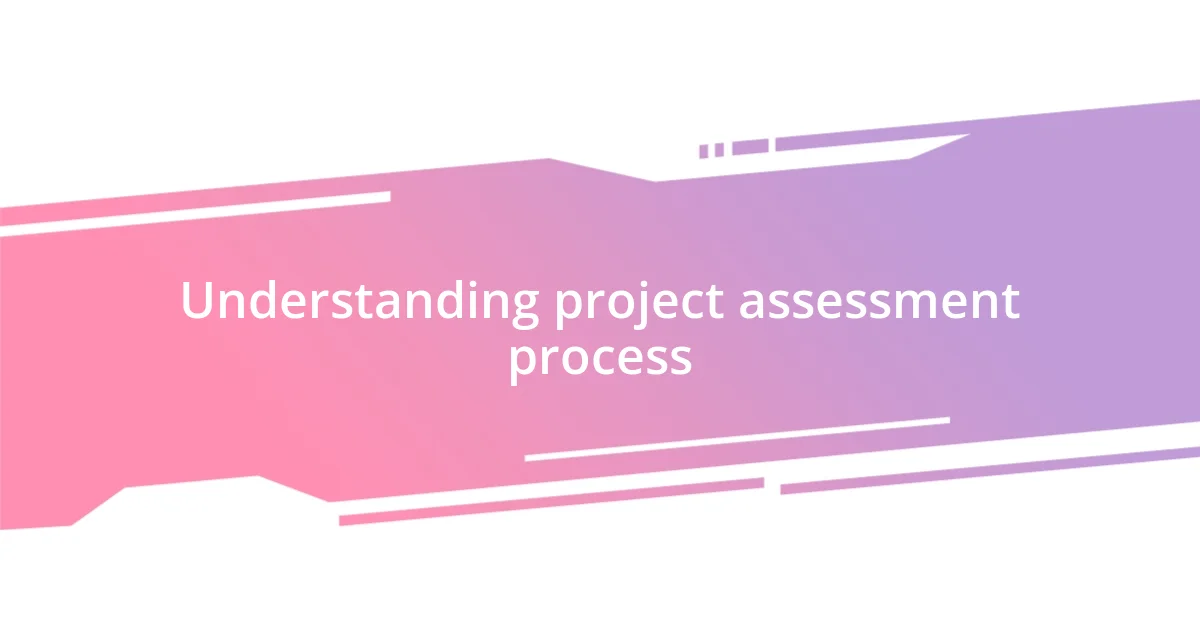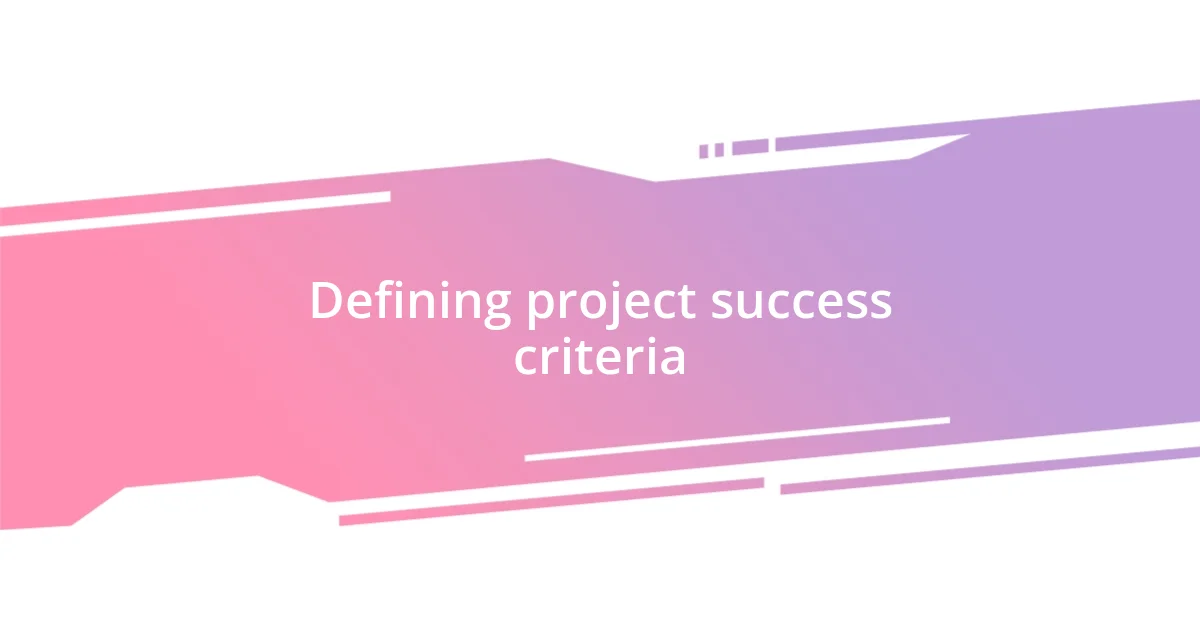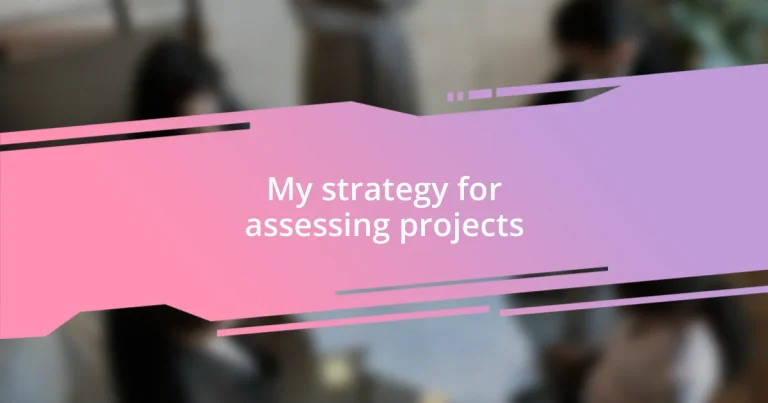Key takeaways:
- Establishing clear project objectives and success criteria is essential for guiding focus and ensuring team alignment.
- Involving stakeholders early and consistently fosters collaboration and helps identify potential risks, improving overall project outcomes.
- Flexibility in assessment methodologies and maintaining open communication throughout the process enhances engagement and adaptability, leading to more effective project assessments.

Understanding project assessment process
The project assessment process is like a roadmap that guides you from the initial idea to the successful completion of a project. I remember a time when I was overwhelmed with a new project; I didn’t know where to start. It was only when I broke down the assessment into clear steps that I could see how to navigate the complexities.
Each stage of assessment, from defining objectives to analyzing risks, plays a crucial role. I once struggled with stakeholder expectations, which made me realize the importance of thorough assessments in aligning project goals. It’s almost like tuning an instrument before a concert; if you don’t take the time to get it right, the end result can be chaotic.
Finally, don’t underestimate the emotional aspect of project assessments. I’ve found that sharing my assessment findings with my team created a sense of ownership and accountability. Have you ever experienced that spark of enthusiasm when everyone is on the same page? It’s a powerful motivator to push a project forward successfully.

Key factors in project evaluation
When it comes to evaluating projects, clarity of objectives is paramount. I once led a project where the goals were vaguely defined. It wasn’t until I convened a meeting with the team to clarify our mission that we gained focus. I learned that without clear objectives, even the most capable teams can flounder. This experience emphasized to me that having precise goals not only streamlines efforts but also energizes the team towards a common purpose.
Another key factor in project evaluation is risk assessment. I vividly recall a project that seemed straightforward until unforeseen issues surfaced. By proactively identifying potential risks during the evaluation phase, I was able to devise contingency plans that saved us weeks of delays. This taught me that the earlier I assess risks, the better prepared I am, leading to smoother project execution. I believe that a project can only be as successful as the strategies put in place to mitigate uncertainties.
Lastly, stakeholder engagement cannot be overlooked. In one of my projects, I neglected to involve key stakeholders early on, thinking it would save time. However, their late input caused significant rework, which wasted resources and time. It’s crucial to keep stakeholders in the loop throughout the evaluation process so that their insights and concerns shape the project from the start. Trust me, when stakeholders feel heard, it promotes a collaborative environment that can pave the way for innovative solutions.
| Factor | Importance |
|---|---|
| Clarity of Objectives | Guides team focus and efficiency |
| Risk Assessment | Identifies potential obstacles and allows for contingency planning |
| Stakeholder Engagement | Fosters collaboration and enhances project buy-in |

Defining project success criteria
Defining project success criteria is essential for measuring how well a project meets its objectives. I remember the project where we didn’t set clear success criteria from the start. Each milestone felt like stumbling in the dark until we finally sat down together and defined what success really looked like for us. Establishing those criteria brought clarity and focus, transforming our approach and giving the team a shared vision.
When thinking about success criteria, consider these key elements:
- Specificity: Success criteria should be clear and specific to avoid ambiguity.
- Measurability: It’s essential to quantify success whenever possible—this helps track progress.
- Relevance: Criteria must align with the project’s goals and the stakeholders’ expectations.
- Time-bound: Setting a timeframe for achieving success creates urgency and keeps the team motivated.
In my experience, when I incorporated these elements into our success criteria, I noticed a renewed sense of purpose within the team. With defined parameters, everyone knew what to aim for, and that collective energy was palpable.

Choosing assessment methodologies
Choosing the right assessment methodology can truly shape the project’s outcome. I often find myself weighing various options, like qualitative versus quantitative methods. For instance, during a complex project I once managed, I quickly realized that a mixed-method approach gave me the comprehensive insights I needed. It combined the richness of detailed feedback from interviews with the hard data from surveys, allowing me to paint a holistic picture of our progress.
Something I always emphasize is the importance of aligning the methodology with the project’s objectives and stakeholders’ needs. I recall a time when a quantitative approach felt suitable for our team, but our stakeholders craved in-depth narratives about the project’s impact. Shifting gears to qualitative assessment not only satisfied their expectations but also enriched our final report. This experience reinforced my belief that methodologies shouldn’t be one-size-fits-all; they should be tailored to truly reflect the project’s context.
Another consideration is the resources available for the assessment. Reflecting on a project that stretched our bandwidth too thin, I learned the hard way that over-ambitious methodologies can backfire. We spread ourselves too thin trying to conduct comprehensive evaluations without enough time or personnel. A quick, iterative assessment process might have brought clarity without the burnout. It’s a delicate balance, and I often ask myself: are we setting ourselves up for success, or are we adding unnecessary pressure? Such reflections guide my choice of assessment methodologies, ensuring they are practical as well as effective.

Collecting and analyzing data
Collecting data is the backbone of any assessment process. I remember a project where we gathered feedback through multiple channels, like surveys, interviews, and focus groups. The variety of perspectives not only enriched our understanding but also made every team member feel valued—after all, isn’t it encouraging when everyone has a voice in the process?
When it comes to analyzing that data, I’ve found that storytelling plays a pivotal role. One time, I helped my team dissect complex data sets and translate the findings into a narrative that everyone could comprehend. Data can often feel abstract and intimidating, but when we framed it in tangible stories, it fostered connection and clarity. This approach sparked deeper discussions about what the numbers really meant for our project.
Another critical point is considering the tools you use for analysis. In one project, I opted for advanced analytics software, thinking it would give us an edge. However, I quickly realized that it overwhelmed the team and stifled collaboration. Sometimes, I ask myself, “Could a simpler tool have achieved the same outcome without the tech-induced stress?” Finding the right balance between sophistication and usability can make a significant difference in how effectively we leverage our collected data.

Making informed decisions
Making informed decisions hinges on evaluating the data we collect. I remember diving into a project where the sheer volume of information felt overwhelming. I often paused to ask myself, “What really matters here?” By prioritizing key metrics that aligned with our strategic goals, I found clarity amidst the noise, which led to choices grounded in genuine insights rather than gut feelings.
Trusting your instincts while weighing options is crucial. There was a specific instance where I had to choose between two potential project directions, each with its own merits. I felt a strong pull toward one path due to my previous successes, but after consulting the gathered data, I pivoted to the alternative approach. That decision not only paid off but also taught me the value of harmonizing intuition with empirical evidence.
Finally, I can’t stress enough the importance of stakeholder engagement in the decision-making process. I once found myself in a room filled with stakeholders who had diverse perspectives on a project direction. By actively listening and incorporating their insights into my analysis, I created a shared vision that everyone felt invested in. It’s a reminder that when we involve others in our decision-making, we often uncover hidden opportunities and prevent potential pitfalls.

Implementing project assessments effectively
Implementing project assessments effectively requires clear communication and a systematic approach. I’ve noticed that setting expectations early on can ease tension and foster a collaborative environment. I once led a project where we kick-started the assessment phase with a simple, open discussion about our goals and concerns, which paved the way for honest feedback later on. Isn’t it amazing how mutual understanding can transform the assessment experience?
I believe engaging the team throughout the assessment process is vital. In a recent project, we held regular check-ins to share insights and adjust our focus areas. This not only kept everyone aligned but also allowed teammates to voice their thoughts and feelings. It made me realize that fostering a supportive atmosphere can lead to deeper insights and a more robust assessment overall.
Moreover, being open to adapting the assessment strategy is crucial. I remember one instance where initial feedback revealed gaps in our approach. Instead of sticking rigidly to our plan, we pivoted, incorporating additional methods like peer reviews and real-time progress tracking. This flexibility not only enhanced our findings but also kept the entire team engaged and motivated. How often do we miss opportunities by holding too tightly to our original plans? Embracing change can unlock significant potential in our projects.














